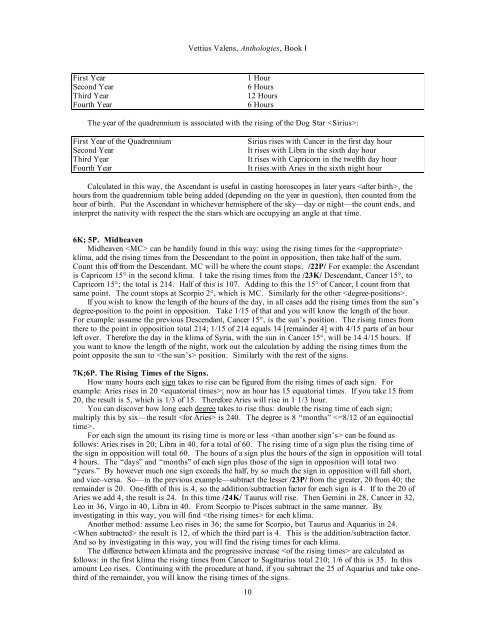Vettius Valens, Anthologies
Vettius Valens, Anthologies
Vettius Valens, Anthologies
You also want an ePaper? Increase the reach of your titles
YUMPU automatically turns print PDFs into web optimized ePapers that Google loves.
<strong>Vettius</strong> <strong>Valens</strong>, <strong>Anthologies</strong>, Book I<br />
First Year 1 Hour<br />
Second Year 6 Hours<br />
Third Year 12 Hours<br />
Fourth Year 6 Hours<br />
The year of the quadrennium is associated with the rising of the Dog Star :<br />
First Year of the Quadrennium Sirius rises with Cancer in the first day hour<br />
Second Year It rises with Libra in the sixth day hour<br />
Third Year It rises with Capricorn in the twelfth day hour<br />
Fourth Year It rises with Aries in the sixth night hour<br />
Calculated in this way, the Ascendant is useful in casting horoscopes in later years , the<br />
hours from the quadrennium table being added (depending on the year in question), then counted from the<br />
hour of birth. Put the Ascendant in whichever hemisphere of the sky—day or night—the count ends, and<br />
interpret the nativity with respect the the stars which are occupying an angle at that time.<br />
6K; 5P. Midheaven<br />
Midheaven can be handily found in this way: using the rising times for the <br />
klima, add the rising times from the Descendant to the point in opposition, then take half of the sum.<br />
Count this off from the Descendant. MC will be where the count stops. /22P/ For example: the Ascendant<br />
is Capricorn 15° in the second klima. I take the rising times from the /23K/ Descendant, Cancer 15°, to<br />
Capricorn 15°; the total is 214. Half of this is 107. Adding to this the 15° of Cancer, I count from that<br />
same point. The count stops at Scorpio 2°, which is MC. Similarly for the other .<br />
If you wish to know the length of the hours of the day, in all cases add the rising times from the sun’s<br />
degree-position to the point in opposition. Take 1/15 of that and you will know the length of the hour.<br />
For example: assume the previous Descendant, Cancer 15°, is the sun’s position. The rising times from<br />
there to the point in opposition total 214; 1/15 of 214 equals 14 [remainder 4] with 4/15 parts of an hour<br />
left over. Therefore the day in the klima of Syria, with the sun in Cancer 15°, will be 14 4/15 hours. If<br />
you want to know the length of the night, work out the calculation by adding the rising times from the<br />
point opposite the sun to position. Similarly with the rest of the signs.<br />
7K;6P. The Rising Times of the Signs.<br />
How many hours each sign takes to rise can be figured from the rising times of each sign. For<br />
example: Aries rises in 20 ; now an hour has 15 equatorial times. If you take 15 from<br />
20, the result is 5, which is 1/3 of 15. Therefore Aries will rise in 1 1/3 hour.<br />
You can discover how long each degree takes to rise thus: double the rising time of each sign;<br />
multiply this by six—the result is 240. The degree is 8 “months” .<br />
For each sign the amount its rising time is more or less can be found as<br />
follows: Aries rises in 20; Libra in 40, for a total of 60. The rising time of a sign plus the rising time of<br />
the sign in opposition will total 60. The hours of a sign plus the hours of the sign in opposition will total<br />
4 hours. The “days” and “months” of each sign plus those of the sign in opposition will total two<br />
“years.” By however much one sign exceeds the half, by so much the sign in opposition will fall short,<br />
and vice–versa. So—in the previous example—subtract the lesser /23P/ from the greater, 20 from 40; the<br />
remainder is 20. One-fifth of this is 4, so the addition/subtraction factor for each sign is 4. If to the 20 of<br />
Aries we add 4, the result is 24. In this time /24K/ Taurus will rise. Then Gemini in 28, Cancer in 32,<br />
Leo in 36, Virgo in 40, Libra in 40. From Scorpio to Pisces subtract in the same manner. By<br />
investigating in this way, you will find for each klima.<br />
Another method: assume Leo rises in 36; the same for Scorpio, but Taurus and Aquarius in 24.<br />
the result is 12, of which the third part is 4. This is the addition/subtraction factor.<br />
And so by investigating in this way, you will find the rising times for each klima.<br />
The difference between klimata and the progressive increase are calculated as<br />
follows: in the first klima the rising times from Cancer to Sagittarius total 210; 1/6 of this is 35. In this<br />
amount Leo rises. Continuing with the procedure at hand, if you subtract the 25 of Aquarius and take onethird<br />
of the remainder, you will know the rising times of the signs.<br />
10

















